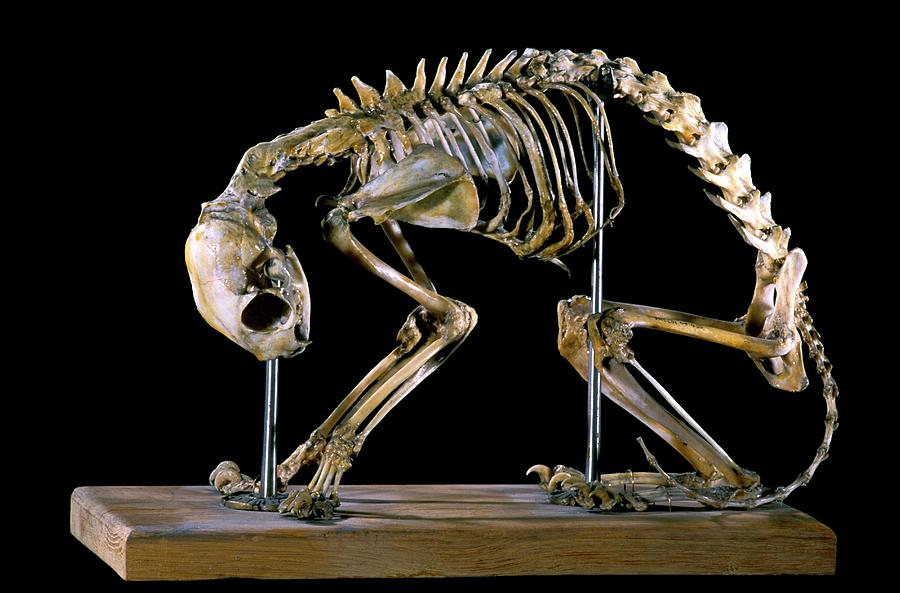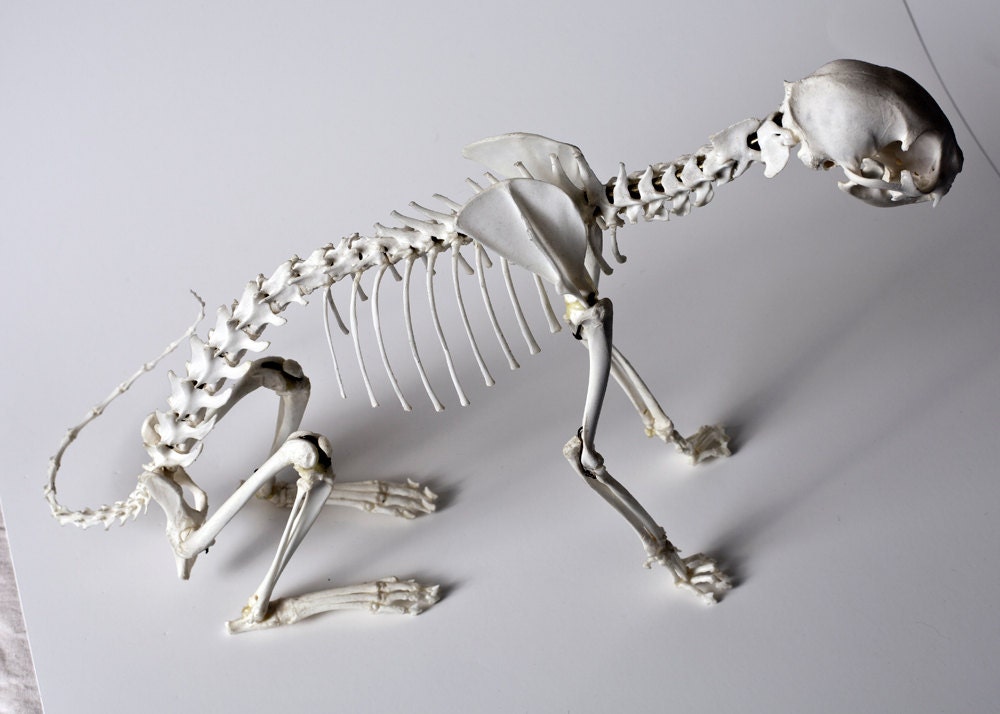
Domestic Cat Skeletal Skull Anatomy Poster 24" X 36" Veterinary
The skeleton is the bony framework of the body that is present in all vertebrate cats, dogs, and animals. It consists of bones, ligaments, and cartilage. The skeleton is composed of the hard tissues of the body, and its primary functions are to support the body, to provide a system of levers used in locomotion, to protect the soft organs of the body, and to produce red blood cells (hematopoiesis).

19th Century Deformed Cat Skeleton Photograph by Patrick Landmann
Everything You Love On eBay. Check Out Great Products On eBay. But Did You Check eBay? Find Skull Kitty On eBay.

Domestic Cat Skeleton 3D model CGTrader
Skeleton of the domestic cat. Anatomy of the domestic cat. Musculature of the cat. Skull of the domestic cat. The bones in a cat's leg. Eye of a domestic cat. (Left) Front paw of cat with claws extend. (Right) A cat's paw seen from underneath.

Domestic REAL CAT SKELETON Articulation Taxidermy Bone Oddity
This specimen is an articulated mounted skeleton of a cat found in the museum alongside several different non-domestic Felis skulls for comparison. Comparing the skeletal structures of different animals has been the business of the Grant Museum of Zoology and Comparative Anatomy for nearly 200 years. Anatomy, zoology and paleontology students.

Available soon, real natural bone, articulated cat skeleton. You can
Big and Bendy. •••. Although humans are much larger, a cat has roughly 250 bones in its skeleton, compared to the 206 bones of the human skeleton. The extra bones in the cat's skeleton are found mainly in the backbone, which gives the cat its extra flexibility and agility. A cat has 52 or 53 vertebrae; humans have 32 to 34.

Cat Skeleton 3D 360 Cat skeleton, Animal skeletons, Cats
The cat has 230 bones, as opposed to 206 within the human body. Skeleton. The skeleton consists of 5 major areas: Spine - cervical, thoracic, lumbar, sacral, caudal regions; Skull; Ribs; Forelimbs; Hindlimbs; When cats experience a musculosketal injury, they are less likely to walk and prefer to hide in a corner or under a bed.

Specimen of the Week 391 The Domestic Cat Skeleton UCL UCL Culture Blog
The cat skull has a short fascial and palatal region as compare to the other common domestic mammals. Inside the cat skull, you will find some air-filled pockets known as sinuses. The cat has sizeable frontal sinus, sphenoid sinus, and maxillary sinus.. A hip bone of the cat skeleton consists of ilium, ischium, and pubis bones. The left and.

Alexis Demetriades Science Illustration Skeleton StudyDomestic Cat
Skeleton of a domestic cat.. While domestic cats are able to swim, they are generally reluctant to enter water as it quickly leads to exhaustion. Urban stressors Noise. Cats living in human settlements are prone to environmental factors that increase cortisol levels. Cortisol is a stress hormone that impacts physiological aspects of the cats.

Cat Skeleton Domestic Cat Skeleton (Felis catus) in 2019 Animal
The thick skull bone protects the cat's delicate brain; other bones include the jawbones (mandible and maxilla), nasal bones, cheekbones and eye orbit. Neck and spine (vertebrae): These bones run along the upper part of the cat's body from the skull to the tail. There are 7 neck bones, 13 backbone, 3 sacral bones and 20-23 tail bones.

Domestic REAL CAT SKELETON Articulation Taxidermy Bone Oddity Free
10. The Basics of the Bones. The average cat has 250 bones, which is more than the average human. Appendicular bones are the bones in the limbs, while bones of the axial skeleton contain the skull.

Cat skeleton, Animal skeletons, Cat anatomy
**The Domestic Cat Skeleton** LDUCZ-Z2602 Felis silvestris catus Domestic cat skeleton (more…) Filed under Grant Museum of Zoology. Tags: amelioration, catus, domestic, dungong, felis, Grant Museum, Grant Museum of Zoology, silvestris, Skeleton, Specimen.

Cat Skeletal Anatomy Laminated Chart X 11 Cm X Cm
Cat skeleton: overview. Lateral view of the cat skeleton. CC-BY Sisina Macchiarelli & Daniel Saugar.

Image result for cat skeleton sitting Art Institute Of Dallas, Lucifer
Let's start with a picture of a domestic cat skeleton to give us a window under our cats' fur.. Well, a typical house cat skeleton has 18 to 23 caudal vertebrae, so this again means that our number of 245 bones is in trouble! Cats with more caudal vertebrae have longer tails, and cats with fewer caudal vertebrae have shorter tails..

Cat skeleton overview Atlas of Comparative Vertebrate Anatomy
The domestic cat has a smaller skull and shorter bones than the European wildcat. It averages about 46 cm (18 in) in head-to-body length and 23-25 cm (9.1-9.8 in) in height, with about 30 cm (12 in) long tails. Males are larger than females. Adult domestic cats typically weigh 4-5 kg (8.8-11.0 lb). Skeleton

Skeletal Anatomy of the Domestic Cat Chart Cat anatomy, Cat skeleton
A complete, real feline skeleton. The cat skeleton comes unassembled and without pre-drilling. This domestic cat skeleton is ideal for teaching and displaying the standard feline bone structure and anatomy. Does not include building instructions, small bones can be loose. Our real animal specimin range by 3B Scientific is prepared by.

Domestic House Cat Skeleton Stock Image C044/5120 Science Photo
A cats skeleton is very similar to that of a human being, however it does lack the shoulder blade bones. This allows freedom of movement of the foreleg, which can be turned in almost any direction. A human has 206 bones, however a cat has around 290 bones and 517 separate muscles, this makes them very agile animals, they use more than 500 muscles to leap, jump and sprint.